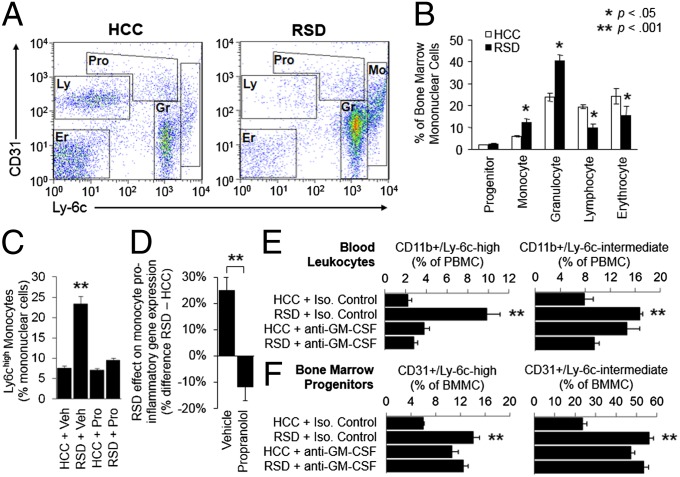Fig. 3.
Role of lineage differentiation and β-adrenergic/GM-CSF signaling. (A) Flow cytometric assessment of mixed-lineage progenitors (Pro), and erythroid (Er), lymphoid (Ly), granulocytic (Gr), and monocytic (Mo) lineage cells in bone marrow. (B) Average prevalence (±SE) of each progenitor cell type (n = 3–7 per condition, representative of three independent experiments). *P < 0.05; **P < 0.001. (C) Effect of the β-adrenergic antagonist propranolol on RSD-induced expansion of splenic Ly-6chigh monocytes. Data represent mean prevalence (±SE) of Ly-6chigh/CD11b+ cells as a percent of total splenocytes (n = 9 per condition; Pro, propranolol; Veh, vehicle). (D) Effect of propranolol on RSD-induced up-regulation of 17 proinflammatory gene transcripts in peripheral blood monocytes (Cxcl1, Cxcl2, Fos, Fosb, Fosl1, Il1a, Il1b, Il6, Jun, Junb, Jund1, Ly6c, Myd88, Ptgs1, Ptgs2, Tlr2, Tnf). Data represent mean percent difference in gene expression (RSD – HCC, ±SE) in vehicle-treated vs. propranolol-treated mice (n = 3 per condition; representative of results from four independent experiments). RSD up-regulated proinflammatory gene expression by an average 25.1% in vehicle-treated animals (P < 0.001) vs. an average −11.7% difference in propranolol-treated animals (P = 0.017). (E) Effect of GM-CSF–neutralizing antibody MP1-22E9 (or isotype control antibody) on average prevalence (±SE) of peripheral blood Ly-6chigh monocytes and Ly-6cintermediate granulocytes (as determined by flow cytometry in n = 8 animals per condition pooled across three independent experiments). (F) Parallel assessment of bone marrow CD31+/Ly-6chigh monocyte progenitors and CD31+/Ly-6cintermediate granulocyte progenitors.

